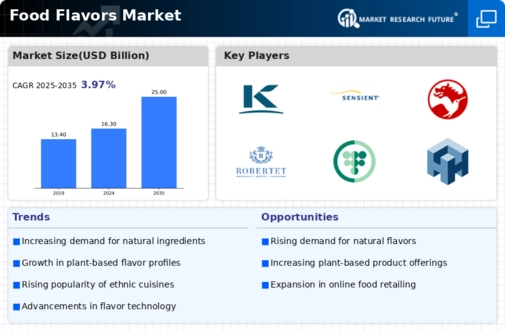Market Growth Projections
The Global Food Flavors Industry is poised for substantial growth, with projections indicating a market value of 25 USD Billion by 2035. This anticipated growth is underpinned by a compound annual growth rate (CAGR) of 3.98% from 2025 to 2035, reflecting the increasing demand for diverse and innovative flavor solutions. As consumer preferences evolve, manufacturers are likely to invest in research and development to create flavors that resonate with market trends. The continuous expansion of the food and beverage sector, coupled with rising health consciousness, suggests a dynamic and evolving landscape for the food flavors market.
Health and Wellness Trends
Health and wellness trends are significantly shaping the Global Food Flavors Industry, as consumers increasingly prioritize nutritious and functional foods. This shift is prompting manufacturers to reformulate products, incorporating flavors that complement health-oriented ingredients. The demand for flavors that enhance the taste of low-sugar, low-fat, and plant-based products is on the rise, reflecting a broader movement towards healthier eating habits. As the market adapts to these trends, flavor companies are likely to innovate, creating flavors that not only taste good but also align with health benefits. This alignment with consumer health trends may further drive market growth in the coming years.
Innovation in Flavor Technology
Innovation plays a pivotal role in the Global Food Flavors Industry, as advancements in flavor technology enable the development of novel flavor profiles. Techniques such as encapsulation and microencapsulation are becoming increasingly prevalent, allowing for the preservation and controlled release of flavors. This technological evolution not only enhances flavor stability but also extends shelf life, catering to the demands of both manufacturers and consumers. As companies invest in research and development, the introduction of unique and diverse flavor combinations is expected to captivate consumers, potentially driving market growth. The continuous evolution of flavor technology may contribute to the projected CAGR of 3.98% from 2025 to 2035.
Rising Demand for Natural Flavors
The Global Food Flavors Industry is witnessing a marked shift towards natural flavors, driven by consumer preferences for clean-label products. As health-conscious consumers increasingly scrutinize ingredient lists, the demand for natural flavoring agents is projected to rise significantly. In 2024, the market is valued at 16.3 USD Billion, reflecting a growing inclination towards organic and naturally derived flavors. This trend is likely to continue, with consumers favoring products that align with their health and wellness goals. Consequently, manufacturers are adapting their offerings to include more natural flavor options, which could enhance their market competitiveness.
Growth of the Food and Beverage Sector
The expansion of the food and beverage sector significantly influences the Global Food Flavors Industry. As the global population continues to grow, the demand for processed and convenience foods rises, necessitating a diverse range of flavors to enhance product appeal. The food and beverage industry is projected to reach a market value of 25 USD Billion by 2035, indicating robust growth. This surge is likely to drive flavor manufacturers to innovate and diversify their product offerings, ensuring they meet the evolving tastes and preferences of consumers. The interplay between food production and flavor development is crucial for sustaining market momentum.
Increasing Popularity of Ethnic Flavors
The Global Food Flavors Industry is experiencing a notable increase in the popularity of ethnic flavors, as consumers seek authentic culinary experiences. This trend is particularly evident in the rise of global cuisine, where flavors from various cultures are being integrated into mainstream food products. As consumers become more adventurous in their taste preferences, manufacturers are responding by incorporating diverse ethnic flavors into their offerings. This shift not only caters to consumer curiosity but also enhances product differentiation in a competitive market. The growing interest in ethnic flavors may contribute to the overall expansion of the market, as brands strive to capture the attention of diverse consumer segments.



















Leave a Comment